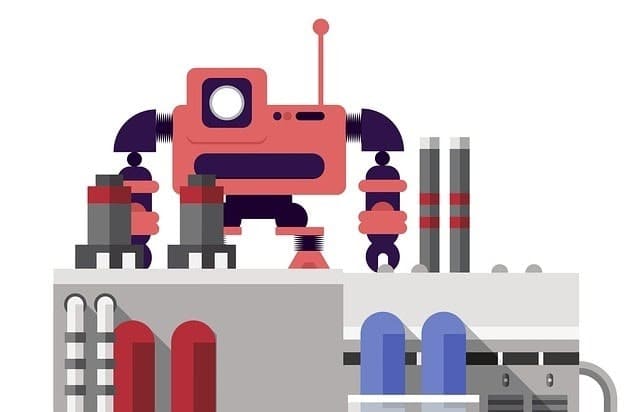For a long, renowned economists have continually expressed their worries about the possible demise of job opportunities since the inception of process automation. With the recent introduction of AI and other technologies, businesses and industries are on the verge of the greatest rush into process automation to increase their efficiency, productivity, and other benefits.
While there is no doubt why process automation is required, experts still ponder how it will change day-to-day activities. To date, experts cannot pinpoint how many jobs or workers can be replaced by process automation. This article highlights the benefits of process automation and its predicted effect on the workforce.

What is Business Process Automation?
Process automation for business involves the use of technology to handle the daily menial tasks of a business. This is a cost-effective and efficient way of streamlining your company’s processes while giving employees ample time to complete high-level tasks. If you are wondering how process automation can be used in businesses, it can be used in nearly all departments, right from human resources, marketing, customer service, and sales.
Benefits of Process Automation
Some top benefits of process automation include
1. Increases Overall Productivity
If implemented effectively, robotics and process automation don’t replace jobs but augment them for greater productivity. Interestingly, in most situations, robots actually drive the creation of new positions in businesses and industries. However, the difference is that it requires different skill sets. Since they lead to the creation of jobs requiring more skills, these jobs can potentially produce high wages.
Based on this, process automation for small businesses will shift the job demand by restricting or lowering the job demand for those who don’t have the right accreditations to work on skilled jobs. Fortunately, several companies have taken measures, such as employee education, to counter these effects of process automation.
2. Process Automation Will Handle Jobs that Humans Shouldn’t Have or Cannot Do
Before worrying about process automation stealing job opportunities, you should focus on the many tasks that can be done by process automation that relieve human workers, especially those that require human workers to be around toxic and dangerous environments.
Relieving human employees from hazardous environments, such as warehouses storing toxic materials or tasks that involve heavy lifting, and freeing them to work on complex human tasks is a win-win. Apart from dangerous jobs, process automation also handles tasks that humans don’t like doing altogether, especially mundane jobs such as conducting inventory. This is a major benefit of process automation in the banking sector.

3. Improved Product Quality
Another great advantage of process automation is its freedom from fatigue. Unlike human employees, robots don’t need sick days or bathroom breaks. They also produce exactly the same product repeatedly with no variation in quality several times. Process automation in salesforce and other office settings also improves service quality. For instance, you can use automation to schedule meetings and appointments, eliminating the possibility of double booking.
4. Saves Time
If you don’t know, working on grunt work often takes more time than expected. Since these activities are important and can’t be skipped, they shouldn’t necessarily be done by humans. Business process automation saves a lot of time by completing menial tasks within a short period. Process automation instantly executes tasks that would normally take time to finish.
That aside, the saved time provides your employees with more time to work on high-level tasks, such as research and building customer relationships. This not only creates more value for your business but also generates more revenue.
5. Reduces Human Error
Human is to error, especially when juggling between words, numbers, and listening to irate customers. However, what can be categorized as petty errors of mixing up numbers escalate into a serious issue if the numbers mixed up are of an invoice. Fortunately, automating paperwork, document transfer, and signatures eliminate these issues.
Examples of Process Automation
Process automation can be used in various business departments. They include;
-
Project Management
Marketers often engage in several projects and marketing campaigns. Incorporating process automation can help digitize workflow and automate campaigns. For instance, using task management tools make it easy to find out who is doing what and it’s due time. Once the employee completes their assigned task, the system automatically notifies the next person in the workflow.
-
Customer Service
Customer service is among the best departments that you can automate. With this, your support team can automate customer replies to specific or repetitive inquiries. You can also create automated answers for Chatbots on social media and websites using FAQs.
-
Social Media
Updating your social media platforms daily is tedious and exhausting. However, this can be eased by using social media automation tools. Some tools can schedule posts, eliminating the need to post manually every day, while others help with content curation.
-
Customer Relationship Management
Managing customer relationships is very important for the success of any business, and you should avoid petty mistakes, such as sending the same email to a prospect twice. Automating customer relationships using various tools can simplify customer engagement. This makes it easy to monitor and nurture leads.
Read: 5 Ways To Use Automation for Customer Acquisition and Retention Rates
How Automation Will Change the Nature of Work
While there is no doubt on why we need to automate processes, it is important to prepare for the impact of process automation on work. Below are some ways in which process automation might change work.
-
Approximately half of the Activities Might Be Automated
A Mckinsey study that analyzed more than 2000 work-related activities across 800 occupations found that some work activities can easily be automated than others. Some easily automated activities include physical activities in very predictable and structured environments, such as data collection and processing. However, these account for approximately half of the activities that employees do in all sectors.
The least susceptible work categories to process automation include interfacing stakeholders, providing expert services, and management. While nearly every occupation is affected by process automation, only 5% can be fully automated by current technologies, while the other portion has activities that can be automated partially. This means that all workers, right from CEOs, mortgage brokers to welders, will work alongside these machines.
-
Some Job Occupations Will Face a Decline
It is not a secret that automation will eventually displace some employees. A study found that approximately 15% of the global workforce, which accounts for an estimated 400 million employees, might be displaced by process automation between 2016 and 2030. These figures project a midpoint scenario in the pace of adopting process automation.
Under a fast-paced scenario, these figures may rise to 30%, or 800 million workers, while the slowest pace scenario estimates that approximately 10 million workers will be displaced. The wide range in these figures is due to various factors that affect the speed of adopting process automation.
Key determining factors include technical feasibility, cost of deployment, labor dynamics, such as labor supply, quality, quantity, and associated wages. Adoption of process automation will also vary significantly across various sectors and countries.
-
Similarly, Jobs Will Be Created By 2030
Despite the imminent displacement of employees, process automation will also increase the demand for jobs. The same study created scenarios affecting labor demand using several factors influencing demand for work, such as rising income, continuous investment in energy, infrastructure, and technology, and increased healthcare expenditure.
Based on these factors, there will be an increase in demand for labor from 21% to 33%, or 555 million to 890 million by 2030, which offsets the predicted number of job losses. Emerging economies, such as India, are among the largest beneficiaries of increased demand for the workforce.
New occupations that cannot be imagined will also emerge and account for 10% of jobs that will be created by 2030. For instance, using history as a guide, the introduction of personal computers in the 1970s created millions of jobs for semiconductor makers, software developers for platforms such as online casino UK, and customer service reps.
-
Busywork Will Be Replaced By Creativity and Problem-Solving
Most employment opportunities in the current workforce are a combination of tasks that process automation can handle with ease. Whether it involves scanning barcodes manually or going through bulky spreadsheets, these tasks are among the first to be replaced by automation.
While this will lead to a significant shift, it might result in positive eventualities. This is because process automation will eliminate repetitive tasks, freeing employees to take up roles that rely on creativity and problem-solving. For instance, while self-checkouts will replace cashier jobs, employees will focus on support and customer service roles.
Similarly, employment positions in warehouses using process automation in inventory control will focus on ensuring accuracy and efficiency.
-
Increased Demand for High and Low Skill Jobs
The US and other economies are in constant demand for high-skill jobs in various fields, such as the engineering and healthcare sectors. Similarly, there are some thriving sectors that process automation isn’t best suited. For instance, the demand for janitorial services will remain on demand for the next decade, despite several process automation technologies.
Unfortunately, the middle-tier jobs, such as everyday office tasks, will be endangered by process automation. A major concern for hallowing out of middle-tier jobs is worsening income inequality between the high-paying skilled jobs and those stuck at the bottom. While there are no clear ramifications of how income inequality will turn out, it creates a sense of urgency on the importance of creating educational programs for training students for future jobs.
-
Social Aspects of Employment Will Become More Important
The importance of social skills is a major bottleneck to successful process automation. Technology experts haven’t discovered how they can create automated empathic responses, social cue-detection skills, and other subtle crucial skills that come with human interaction. Interestingly, these technological shortcomings won’t likely be solved soon.
Therefore, the demand for people skills will increase considerably amidst process automation. According to the BLS, there will be increased demand for skills that focus on the human side, such as social workers, substance abuse counselors, psychologists, and therapists. That said, even as process automation continues to take root, there is a need to continue cultivating social skills and humanity.
-
Deep Learning and AI Will Necessitate Rigorous Data Collection and Filtering
An important fact that proponents of process automation, such as machine learning and artificial intelligence, agree on is the importance of feeding process automation tools with accurate and unbiased data. A major challenge of process automation is its vulnerability to the “garbage-in, garbage-out” problem. Typically, if data that process automation relies on is not substantiated, it will likely produce harmful and useless results.
Incorporating process automation into the hiring process has clearly highlighted the urgency of this issue. Several hiring examples have shown that using poorly or skewed algorithms during the hiring process can lead to biased results, including gender and color discrimination. Therefore, to improve diversity, hiring managers should ensure that they use accurate data.
-
Work Will Be Distributed Globally
The internet has caused shifts in the employment landscape, and it will likely continue with more tasks requiring only a computer, internet connection, and smartphone to be done. With continuous process automation, work is no longer a place but a thing that you do. The effects of remote and decentralized employment will be global.
The surge in digital normalcy means that a freelancer can code for a Florida-based agency from Italy. Fortunately, this work-from-home culture offers great opportunities for people with disabilities and stay-at-home parents. This has been fostered by several process automation tools that enable remote employees to collaborate and communicate beyond continental borders.

Conclusion
Despite the unstoppable process automation, there is work today, and there will be work in the future. However, future work will be slightly different, requiring that employees acquire new skills and adapt to various work process automation. Training and retraining the new generation and middle-tier employees is imperative to minimize the effects of these looming challenges. That said, how has process automation changed your workplace? Share your challenges as well.















